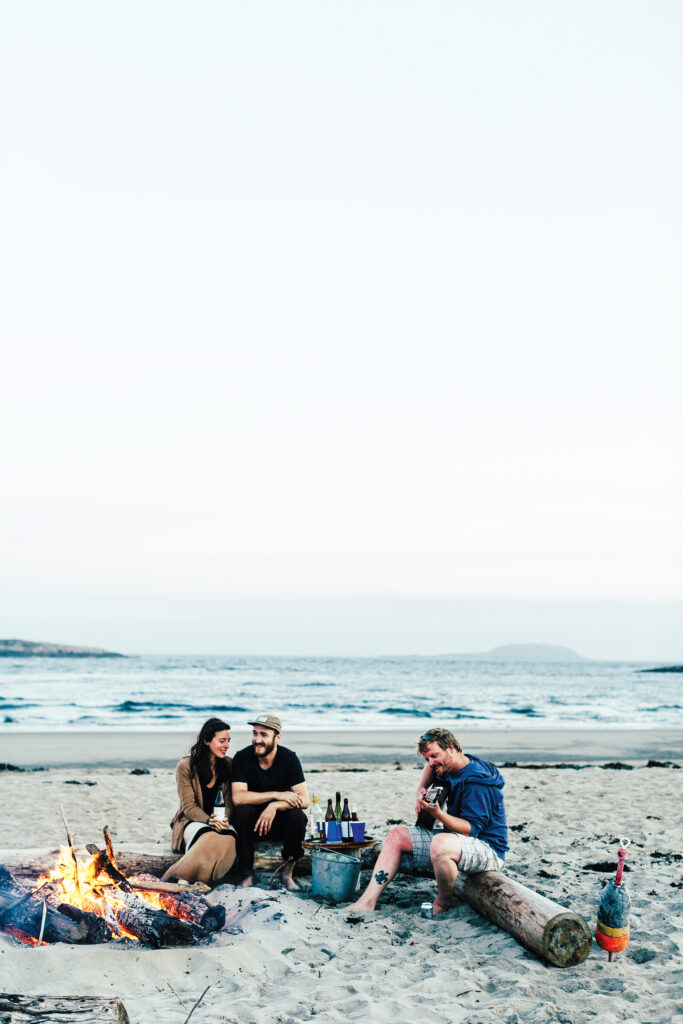By Sandy Oliver
Photos by Michael Piazza
Styled by Catrine Kelty
From our May 2016 issue
One Victorian writer described the clambake as the “jolliest festival” of New England summers. A feast of clams, lobster, and corn on the cob, the beach tradition originated several millennia earlier, when humankind worldwide discovered the utility of hot-rock cookery. As many Native American oyster and clamshell middens along Maine’s shoreline attest, we are merely the latest of the tribes visiting the coast in summer to fill up on shellfish.
Yankee lore holds that the Wabanaki people taught early southern New England settlers how to cook shellfish in seaweed over fire-heated stones — a logical theory, although there’s no historical documentation or archeological evidence for it. We do know that the indoor shellfish feasts that colonists prepared to honor their forefathers evolved into outdoor picnics called “squantums.” Those, in turn, evolved into clambakes, and the tradition probably traveled to Maine with rusticators in the early 1900s. These days, clams are pricey, so lobsters dominate at beach banquets.
A “true” lobster bake is a daylong affair that begins with a driftwood fire that turns rocks white hot, a process that takes two to three hours. Resourceful Mainers that we are, we speed up the process by building a fire under a large metal plate or foil-covered grate that serves as the cooking surface. Rockweed spread over the rocks (or plate) generates billows of fragrant seawater steam that cooks the lobsters as the seaweed’s bladders pop. A gentle smokiness suffuses the shellfish and corn. Sure, it’s easier to boil them, but who’d want to do that?
Total time, including prep and clean-up: 4 hours. Cost: roughly $40 per person
INGREDIENTS
lobster (1 to 2 per person)
corn, unshucked (1–2 ears per person)
small red potatoes (3–4 per person)
yellow onions (1 per person)
carton of eggs (1 for every dozen people)
steamer clams (⅓ pound, roughly 5–10
clams, per person)
MATERIALS
4 cinder blocks
newspaper
large metal sheet or grill grate
seaweed
oven mitts
paper towels
cheesecloth, to loosely tie up the clams
plastic-lined tablecloths
silverware
kindling and wood
matches
heavy-duty aluminum foil
coolers for seaweed and food storage
large platters
lobster crackers
large tongs
small plastic condiment cups
large, sturdy paper plates
A Step-by-Step Guide
1. Start by finding a location. It’s best to do it on your own property, but any campfire station or beach pit will do (check first that fires and/or wood gathering are allowed).

2. Stand four cinder blocks on end to make a square foundation, in the middle of which you will build a fire.
3. Prep the fire with kindling, newspaper, and logs, but don’t light it just yet.
4. Place a heavy sheet of metal over the wood so that it is sturdy and centered, with the four corners resting on top of the cinder blocks. An alternative is to use a regular grill top covered with four layers of heavy-duty aluminum foil to prevent scorching.
5. On the metal sheet, make a thick bed of fresh rockweed large enough to nestle all the food into. Gathering it is fun for families — get property owner permission, check for low tide times, and cut (don’t pull) it off the rocks. Leave at least 16 inches of live seaweed, says the Department of Marine Resources.
6. Nestle some eggs (still in the carton), potatoes, and onions in the seaweed. Place the live lobsters, clams, and ears of corn on top. Reserve a few clams for the clam broth.
7. Cover the food with more seaweed.
8. Cover the seaweed with foil (making sure to tuck it between the seaweed and the metal sheet so you create a little oven where all the heat stays inside the foil).
9. Cover the foil with another layer of seaweed to keep it from blowing away.
10. Light the fire. The flame should be steady and very hot. Let food cook for 1¼ hours while continuing to feed the fire. Then let it die down slowly while the food continues to cook, about another half hour.
11. Use oven mitts to remove the food, and then enjoy most everything with drawn butter and lots of paper towels.
Accoutrements
• Lots of drawn butter for the lobster and clams, served in condiment cups.
• Clam broth for dunking the clams before they are dipped in butter. To make it, throw a few uncooked clams in a medium pot of water and boil for 30 minutes. Serve in condiment cups along with the butter.
• Rolls (because you can’t have too many ways to soak up butter).
• Libations: red and white wine, an assortment of beers, lemonade, and sparkling water (check rules for alcohol consumption in public places).

For the pie
5 cups wild blueberries (half fresh,
half frozen)
¾ to 1 cup sugar
2 tablespoons flour
¼ teaspoon cinnamon
standard single pie crust recipe (or store-
bought crust)
For the topping
1 stick unsalted butter, softened
¾ cup sugar
1 cup flour
Preheat the oven to 400 degrees. Mix pie ingredients in a large bowl and then pour into the crust. To make the crumb topping: With a fork, mix the butter, sugar, and flour until it forms little crumb-like balls. Pat the topping over the blueberries. Bake for 45–55 minutes. Bake it on a cookie sheet because it can bubble over and make a mess. Cool before cutting. It will be a bit runny, but that way it mixes so well with vanilla ice cream! If you’re more into your pies staying congealed, add a bit of cornstarch.






